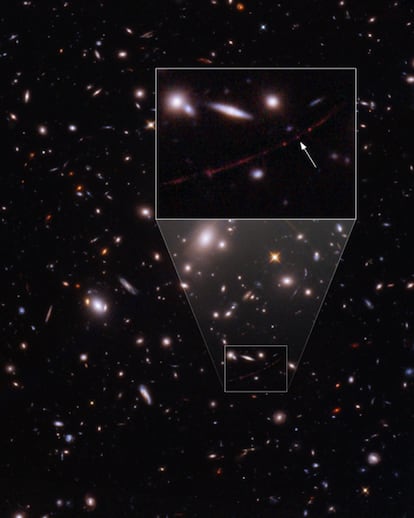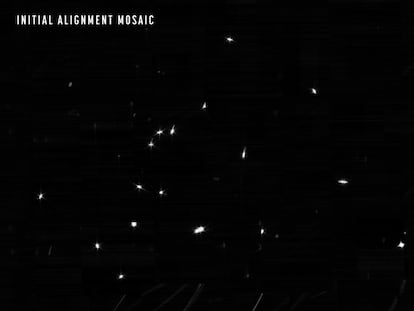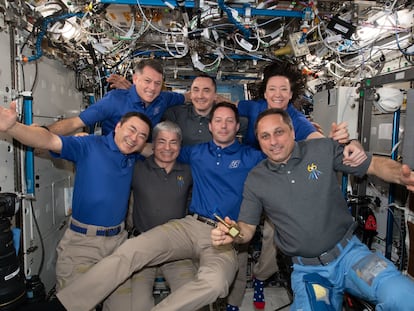Hubble space telescope discovers Earendel, the farthest known star
Located 12.9 billion light years away, it disappeared after a massive explosion but scientists can still learn a lot about its composition

The Hubble space telescope has discovered the most distant star ever observed. Earendel is at least 50 times bigger than the Sun, and its temperature is 20,000ºC. It is 12.9 billion light years away – meaning that to get there, one would have to travel at the speed of light for 12.9 billion years. And the star is already dead anyway: the light observed by Hubble was emitted 12.9 billion years ago, 900 million years after the Big Bang that created the universe.
Astronomers estimate that Earendel exploded millions of years ago. The Hubble was able to detect it thanks to a coincidence. As German physicist Albert Einstein predicted with the theory of general relativity, the gravitational force of very large bodies can act as a lens that amplifies the light of objects that are much further away. In this case, a cluster of closer galaxies has magnified Earendel’s light.
“We see the light of the star now as it was 12.9 billion years ago, before it exploded,” said José María Diego, an astronomer at the Cantabria Physics Institute (IFCA-CSIC) in northern Spain who co-authored a study explaining the discovery. “We don’t know how long it lived, but certainly less than 100 million years, which is very little compared to other stars like the Sun, which can live 100 times longer. The light from its explosion hasn’t reached us yet, but it’s on its way, and it will arrive within the next 100 million years at the most.”
Earendel is in a galaxy known as Sunrise, whose light has been magnified and distorted by gravitational lenses. “Imagine a curved piece of glass that deforms the image we see through it,” said Diego. “A gravitational lens amplifies the light of faraway objects that are aligned behind a cluster of galaxies. Those galaxies re-route the light of faraway stars, since their enormous mass deforms space-time around them.”
The new star’s name means “morning star” or “rising light” in Old English, as the star’s discoverers explain in a study published in Nature. As the National Research Council of Spain (CSIC) noted in a press release, the name also pays tribute to the 1914 poem The Voyage of Earendel the Evening Star, written by John R. R. Tolkien, author of The Lord of the Rings.
With this discovery, the Hubble has shattered its prior record for the most distant star observed. In 2018 it detected Icarus, a blue supergiant star nine billion light years away.
Earendel is part of the universe’s first generation of stars, which emitted the first light and brought the cosmos out of the dark. “These primordial stars have eluded observers until now, but now they can be detected if observed through magnifying gravitational lenses, as in the case of Earendel,” said Brian Welch, an astrophysicist at Johns Hopkins University in Baltimore and lead author of the Nature paper.
The team’s next step will be to observe the star with the James Webb Space Telescope, the most powerful device of its kind. The primary goal of the new space observatory, developed by the United States, Europe and Canada, is to capture the first light in the universe emitted by stars similar to this one. “Combining the observations of the Hubble and Webb will allow us to learn about the microlenses in the galaxy clusters, which could include exotic objects like primordial black holes,” said Welch.
The James Webb telescope will also be able to clarify the primitive star’s composition, believed to contain only with the lightest elements, as metals and other heavy compounds, which formed after the explosions of dead stars, did not exist yet.
“It is an amazing discovery,” said Pablo G. Pérez-González, an astronomer at Spain’s Astrobiology Center ((CAB/CSIC-INTA) who works with the James Webb telescope and who also participated in the discovery of Icarus. “It’s very hard for us to find stars this massive in the Milky Way or in nearby galaxies, because there are not many, and they do not last long. We cannot usually distinguish individual stars in almost any galaxy.”
Now, astronomers hope to use the Webb to keep discovering these objects, though it is not an easy task. Researchers must observe the same region of the sky over and over, until they get lucky.
Tu suscripción se está usando en otro dispositivo
¿Quieres añadir otro usuario a tu suscripción?
Si continúas leyendo en este dispositivo, no se podrá leer en el otro.
FlechaTu suscripción se está usando en otro dispositivo y solo puedes acceder a EL PAÍS desde un dispositivo a la vez.
Si quieres compartir tu cuenta, cambia tu suscripción a la modalidad Premium, así podrás añadir otro usuario. Cada uno accederá con su propia cuenta de email, lo que os permitirá personalizar vuestra experiencia en EL PAÍS.
¿Tienes una suscripción de empresa? Accede aquí para contratar más cuentas.
En el caso de no saber quién está usando tu cuenta, te recomendamos cambiar tu contraseña aquí.
Si decides continuar compartiendo tu cuenta, este mensaje se mostrará en tu dispositivo y en el de la otra persona que está usando tu cuenta de forma indefinida, afectando a tu experiencia de lectura. Puedes consultar aquí los términos y condiciones de la suscripción digital.
More information
Últimas noticias
The complicated life of Francesca Albanese: A rising figure in Italy but barred from every bank by Trump’s sanctions
From digital curfews to blocking apps: How technology experts protect their children online
Why the price of coffee has skyrocketed: from Brazilian plantations to specialty coffee houses
Confined to a Cuban hospital: When electricity is a matter of life or death
Most viewed
- Pablo Escobar’s hippos: A serious environmental problem, 40 years on
- Why we lost the habit of sleeping in two segments and how that changed our sense of time
- Trump’s obsession with putting his name on everything is unprecedented in the United States
- Charles Dubouloz, mountaineering star, retires at 36 with a farewell tour inspired by Walter Bonatti
- The Florida Keys tourist paradise is besieged by immigration agents: ‘We’ve never seen anything like this’











































